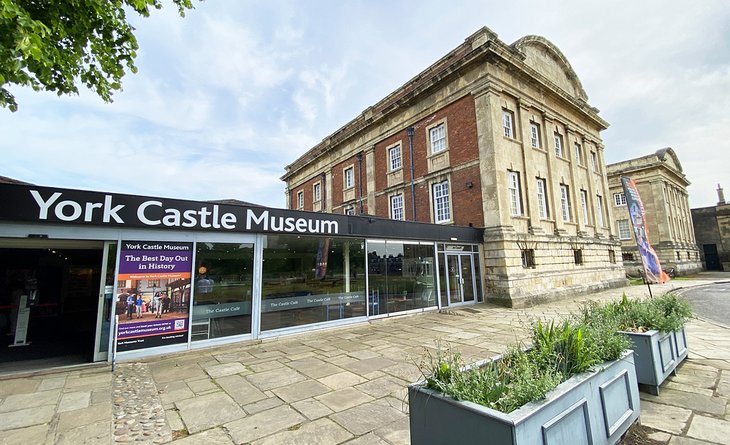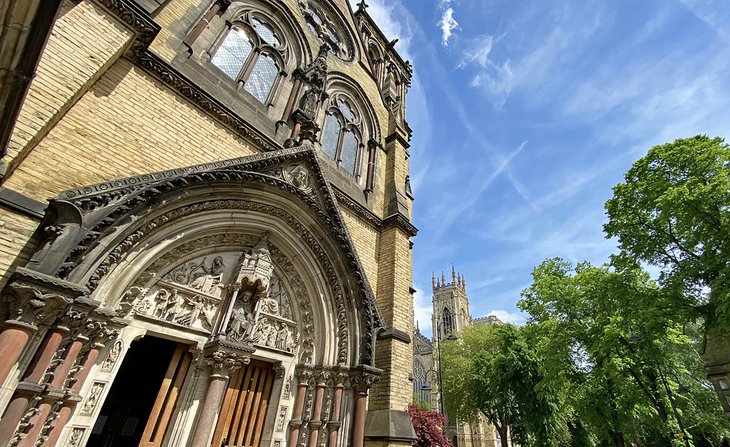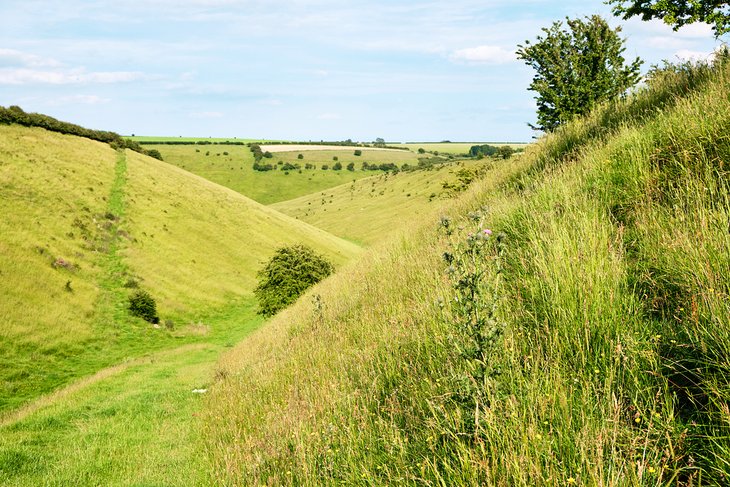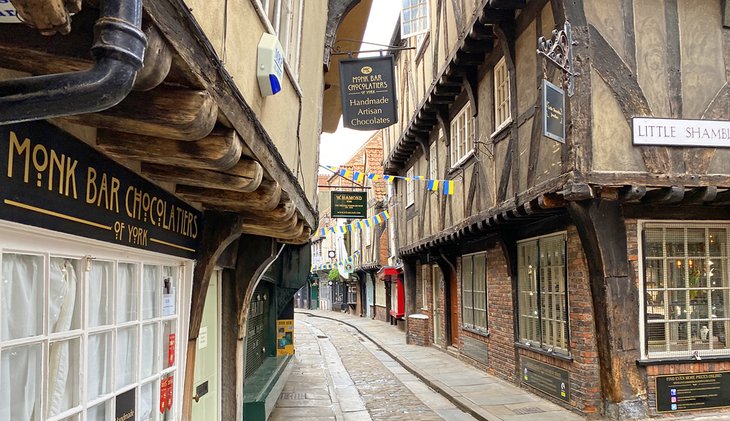York
Top-Rated Tourist Attractions in York, England
Although Yorkshire has long been divided into four counties, York is still considered the capital of this lovely corner of Northern England. It's also the ecclesiastical capital of the Church of England, the Archbishop of York being second only to the Archbishop of Canterbury. The Lord Mayor of this medieval city enjoys the same status as his counterpart in London, and the Duke of York title is given to the second oldest son of Britain's sovereign. The city is filled with things to do and with attractions that reveal the many layers of its long history. It's also home to York Minster, the largest medieval church in England, as well as the longest circuit of medieval city walls, nearly three miles long and offering marvelous views of the city. A handy hop-on, hop-off sightseeing bus takes in most of the major points of interest to tourists.
1 York Minster
Imposing York Minster commemorates the monks who converted those living in the surrounding countryside to Christianity. Dedicated to St. Peter, York Minster's bishops even sat on the council at Arles in AD 314. After this, little is known until AD 627, when the oldest documented (wooden) church was built here for the baptism of King Edwin of Northumbria. Succeeding Saxon and Norman constructions were destroyed, and the present cathedral was built in the Gothic style in the 13th century.
Highlights of a tour include the Minster's impressive stained glass windows, most notably the Pilgrimage Window (dating from about 1312) resting above a stunning dragon's head, depicting Peter surrounded by pilgrims along with unusual details such as the funeral of a monkey. Also of interest is the Treasury, with its interactive galleries portraying the building's colorful history from its Roman roots to today. Displays include more than 2,000 years of remarkable artifacts found nearby that provide an insight into the cathedral's important role over the centuries. And if you've got a head for heights, York Minster's spectacular medieval Central Tower - the highest point in the city - involves a climb of 230 feet up 275 steps and offers a close-up view of some of the cathedral's most interesting decorative features, including its pinnacles and gargoyles. Once outside, all that hard work will be rewarded with superb views of York's historic city center.
2 Walking the Medieval City Walls
A walk along York's medieval city walls leaves a lasting impression of this beautiful city. Built mainly in the 14th century, the walls incorporate some of the city's original Roman structures and total some three miles in length. Four of the old gates have been preserved: Walmgate Bar, Monk Bar, and Bootham Bar, all with their original portcullis, and Micklegate Bar with its three knights. The stretch of wall between Bootham Bar and Monk Bar offers excellent views of York Minster. (If time permits, pop into the Richard III Experience in Monk Bar and the Henry VII Experience at Micklegate Bar, with their fascinating take on the lives of two of England's best-known medieval kings.)
3 Clifford's Tower
Located between Fishergate and Skeldergate Bridge, York Castle was built of wood by the Normans in 1068. The oldest remaining part is Clifford's Tower. Constructed in the 13th century as a replacement for the wooden fortress, it was named after Roger de Clifford, executed here in 1322 as leader of the Lancastrian party. It was also infamous as the place where the king would put those he had executed on display. Today, the castle is popular for its stunning views.
4 York Castle Museum

York Castle Museum offers a marvelous insight into the English way of life throughout the centuries. Highlights include Kirkgate, a perfect recreation of a Victorian street, complete with shops; Toy Stories, a history of children's toys; and a Victorian parlor and 17th-century dining room. Another fascinating exhibit is The Cells in the old Debtors Prison, including the former Condemned Cell once occupied by highwayman Dick Turpin (the site has in fact been a place of incarceration for more than 1,000 years, with the York Crown Court still holding those accused of serious crimes). Afterwards be sure to check out the museum's database of former prisoners and victims going back hundreds of years for mention of any relatives!
5 Ramble through the Shambles
One of York's biggest tourist attractions is the Shambles, a narrow 14th-century thoroughfare with lovely overhanging timber-framed buildings. Once known as "The Great Flesh Shambles" for its numerous butcher shops and stalls (meat hooks can still be seen outside many shop fronts), the area is now a mix of shops, restaurants, tearooms, and boutiques. The Shambles is also where you'll find five of York's fascinating Snickelways, a collection of small streets and winding footpaths connecting the old city.
6 Jorvik Viking Centre

The Jorvik Viking Centre in Coppergate documents the daily lives of the Vikings in 9th-century York, or "Jorvik." The site includes reconstructions of Viking dwellings and medieval workshops and is built above the remains of 1,000-year-old wooden houses. The museum also hosts on- and off-site reenactments, as well as opportunities for young and old alike to dress up and play Vikings (without, of course, any of the pillaging).
7 National Railway Museum

The National Railway Museum has an impressive array of locomotives and carriages dating from 1820 to the present day. Among the many exhibits in the Great Hall, laid out like an old-fashioned railway station, are a Victorian mail train from 1838, turn-of-the-century freight and steam trains, and luxurious Edwardian Pullman carriages. Also on display is a collection of Royal Trains, including carriages once used by Queen Victoria. If possible, try to time your visit to coincide with one of the daily demonstrations of the facility's vintage turntable for an up-close look at how these massive machines were turned around. The museum also boasts more than a million artifacts ranging from posters to paintings, along with more than 1,000 hours of unique recordings relating to Britain's rich railway history.
8 Castle Howard
An easy 30-minute drive northeast of York is majestic Castle Howard. Set amid 1,000 acres of parkland and richly furnished with antiquities and treasures, family-owned Castle Howard is undoubtedly one of England's most spectacular country estates. This magnificent Palladian mansion - famous as the backdrop for acclaimed TV drama Brideshead Revisited - was built for the third Earl of Carlisle by dramatist-turned-architect John Vanbrugh. Its many elegant rooms contain paintings and carvings, period furniture, and costumes, as well as valuable vases and statues. The grounds are on a scale to match the house, with an impressive family mausoleum, an obelisk, a pyramid, and the lovely Temple of the Four Winds. And, of course, there's the spectacular fountain at the front of the mansion, perfect for the ultimate "selfie."
9 Yorkshire Museum and Gardens

Along with its superb geological and natural history collections, the Yorkshire Museum contains many important Roman and Anglo-Saxon archaeological artifacts. It's also where you'll find the 1,000-year-old Cawood Sword, the best preserved such Viking weapon in the world. Medieval sculptures and utensils are exhibited in St. Mary's Abbey. Be sure to spend time in the lovely - and free - Museum Gardens. Extending across some 10 acres in the heart of the old city, this beautiful garden is home to more than 40 species of birds, as well as trees, shrubs, and flowers under the ruined walls and arches of the medieval St. Mary's Abbey. Recently expanded, the gardens now include an Edible Wood and an Artists Garden, an outdoor gallery with rotating exhibits.
10 Stonegate and Barley Hall

The area between Coney Street and King's Square near York Minster is a bustling pedestrianized shopping quarter famous for its narrow cobbled streets and charming shops and cafés. It's where you'll find old St. Helen's Church, named in honor of the mother of Emperor Constantine, with its 15th-century stained glass windows. It's also where you'll find the Mansion House, designed by Lord Burlington. Built in 1725, it's now the official residence of the Lord Mayor. Also worthy of a visit in Stonegate is Barley Hall, a 14th-century townhouse that aims to provide an authentic look at life during medieval times.
11 Exploring the River Ouse by Boat or on Foot
Spend time exploring the riverbanks of the River Ouse, which splits York in two. In addition to its numerous lovely gardens, you can see wonderful examples of riverside architecture, such as the majestic 15th-century Guildhall. Another view of York is from a cruise on the river, either on an all-weather passenger boat or on a self-drive motor boat. In the summer, cruises also go to Bishopthorpe Palace, the riverside residence of the Archbishop of York.
12 York's Many Churches

Two of York's prettiest churches are St. Martin-le-Grand in Coney Street, a charming mix of medieval and modern architecture, and St. Michael's in Spurriergate, with its 12th-century arcades, glass paintings, and impressive 18th-century altarpiece. Other churches of note include St. Mary's in Bishophill Junior, with its Saxon tower and an altar by Temple Moore; St. Denys' in Walmgate, with 14th-century stained-glass windows; St. Margaret's (also in Walmgate) with its Roman doorway and tower; and attractive little Trinity Church (14th century) in Goodramgate, with its small garden. The 15th-century All Saints Church in North Street is notable for its stained-glass windows.
13 Beverley: Yorkshire's Other Minster
Just 29 miles from York, the attractive old market town of Beverley lies in the foothills of the East Yorkshire Wolds. Its best-known landmark is the impressive Beverley Minster, a 334-foot-long cathedral made even more famous for its starring role as a stand-in for London's Westminster Abbey in the hit TV series, Queen Victoria. Notable highlights include its lovely Romanesque marble font and the Maiden's Tomb. The choir is a magnificent example of Early English architecture, and its choir-stalls (1520) have the largest number of misericords in England (68). Other things to do in Beverley include visiting St. Mary's, a cross-shaped church begun in the 12th century, and attending the Beverley Early Music Festival in May, which highlights both early music and the architectural heritage of the town.
14 Yorkshire Wolds Way

Part of the National Trail Network, Yorkshire Wolds Way passes through the delightful scenery of the North Yorkshire Moors and the Yorkshire Wolds, which in places rises to heights of up to 800 feet. This 80-mile trail runs from Filey near Scarborough on the North East Coast south to Hull. Along the way, you can stop off at quaint B&Bs or well-equipped campsites (the full trail takes six days to complete), or simply tackle one or two highlights such as the deserted medieval village of Wharram Percy.







Comments
Post a Comment